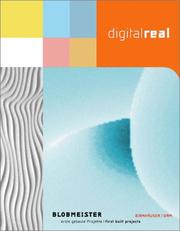| Listing 1 - 3 of 3 |
Sort by
|

ISBN: 4887061986 9784887061989 Year: 2001 Publisher: Tokyo : Toto,
Abstract | Keywords | Export | Availability | Bookmark
 Loading...
Loading...Choose an application
- Reference Manager
- EndNote
- RefWorks (Direct export to RefWorks)
Published on the occasion of the exhibition "Le Corbusier in his Houses", Tokyo 2001. Charles-Édouard Jeanneret, otherwise known as the Swiss architect Le Corbusier, is famous for proclaiming “the house is a machine for living in”. This neat comparison of 106 of his designs for houses edited by Tadao Ando Laboratory (with model, as well as plan and side views), each house to one spread, sets Le Corbusier’s experiments in perspective. Two essays discuss the theory behind his designs and what they reveal about the man himself.
Architecture, Domestic --- Architectural models --- Architecture, Modern --- Exhibitions --- Le Corbusier, --- Le Corbusier (pseudoniem van Charles-Edouard Jeanneret 1887-1965 (°La Chaux-de-Fonds, Neuchâtel, Zwitserland) --- Woningbouw ; 20ste eeuw ; Le Corbusier --- Architectuur ; maquettes ; schaalmodellen --- Le Corbusier --- Jeanneret, Charles-Edouard --- Moderne Beweging --- 72.07 --- Architecten. Stedenbouwkundigen A - Z --- Architecture, Domestic - Designs and plans - Exhibitions. --- Architectural models - Exhibitions --- Architecture, Modern - 20th century - Exhibitions. --- Le Corbusier, - 1887-1965 --- Habitations individuelles --- Conception et construction --- Dessins et plans. --- Le Corbusier (1887-1965)


ISBN: 3764365722 9783764365721 Year: 2001 Publisher: Basel Birkhäuser
Abstract | Keywords | Export | Availability | Bookmark
 Loading...
Loading...Choose an application
- Reference Manager
- EndNote
- RefWorks (Direct export to RefWorks)
virtual reality --- blob architecture --- computer-aided design --- Architecture --- Computer. Automation --- Hadid, Zaha --- Gehry, Frank --- Oosterhuis, Kas --- Van Egeraat, Erick --- Asymptote --- anno 1900-1999 --- Architecture virtuelle --- Projet d'architecture --- Architecture contemporaine --- Computer-aided design --- Architectural design --- Architecture, Modern --- Graphisme sur ordinateur --- Informatique appliquée --- Informatique graphique --- Représentation de l'architecture --- Représentation de l'espace --- Représentation graphique en architecture --- Data processing --- Franken, Bernhard --- Gehry, Frank O. --- Farlane, Jakob --- Farlane, Mac --- Kolatan, Sulan --- Mac Donald, William J. --- Abb architects --- Asymptote architecture --- 72.012/013 --- Blobmeister --- CAAD --- Computer aided architectural design --- Digitale architectuur --- Contains audio-visual material --- Exhibitions --- Design --- Structural design --- CAD (Computer-aided design) --- Computer-assisted design --- Computer-aided engineering --- Gehry, Frank Owen --- Computer. Informatica. Automatisering --- Architectuur --- computer aided design --- blobarchitectuur --- Egeraat, van, Erick --- Hadid, Zaha, --- Computer-aided design - Exhibitions --- Architectural design - Data processing - Exhibitions --- Architecture, Modern - 20th century - Exhibitions --- Hadid, Zaha, 1950-2016 --- computer-aided design [process]

ISBN: 0870700391 0810962225 9780810962224 9780870700392 Year: 2001 Publisher: New York (N.Y.) New York (N.Y.) Colombus Harry N. Abrams Museum of Modern Art Wexner Center for the Arts
Abstract | Keywords | Export | Availability | Bookmark
 Loading...
Loading...Choose an application
- Reference Manager
- EndNote
- RefWorks (Direct export to RefWorks)
Perfect Acts of Architecture collects six sets of highly inventive drawings by contemporary avant-garde architects Rem Koolhaas and Elia Zenghelis, Peter Eisenman, Bernard Tschumi, Daniel Libeskind and Thom Mayne. Created between 1972 and 1988 (when many architects turned to teaching as economic conditions had drastically curtailed building commissions), these works reflect the period's intellectual debates and propose graphic experimentation as a mode of research. Each suite of drawings offers great insight into the creative processes of six young designers, who have since gone on to establish major international reputations. Setting this "paper architecture" in a broader historical backdrop, Jeffrey Kipnis and Terence Riley provide introductory texts and concise commentaries on each of the projects.
Modern [styles and periods] --- Architecture --- architecture [discipline] --- Eisenman, Peter --- Libeskind, Daniel --- Tschumi, Bernard --- Koolhaas, Rem --- anno 1900-1999 --- anno 2000-2099 --- Mayne, Thom --- Architecture, Modern --- Architectural drawing --- Architecture contemporaine --- Dessin d'architecture --- Plan d'architecture --- Vriesendorp, Madelon --- Zago, Andrew --- Zenghelis, Elia --- Zenghelis, Zoe --- Architectuur ; architectuurtekeningen ; 1972-1987 --- Architectuur en digitalisering --- Tentoonstellingscatalogi ; New York ; MOMA --- 72.038 --- 741:72 --- (069) --- 72.02 --- 72.012/013 --- Architectuurgeschiedenis ; 1950 - 2000 --- Tekenkunst ; architectuurtekeningen --- (Musea. Collecties) --- Architectuurtekenen --- Tekenen (architectuur) --- Ontwerptekenen --- Ontwerp (architectuur) --- Architectuurontwerp --- Modern [style or period] --- Eisenman, Peter, --- Koolhaas, Rem, --- Libeskind, Daniel, --- Exhibitions. --- Tschumi, Bernard, --- Drawing, Architectural --- Plans --- Architectural design --- Communication in architectural design --- Drawing --- Mechanical drawing --- Architecture, Modern - 20th century - Exhibitions. --- Architectural drawing - Exhibitions. --- Eisenman, Peter, 1932 --- -Koolhaas, Rem, 1944 --- -Libeskind, Daniel --- Tschumi, Bernard, 1944 --- -Vriesendorp, Madelon
| Listing 1 - 3 of 3 |
Sort by
|

 Search
Search Feedback
Feedback About
About Help
Help News
News